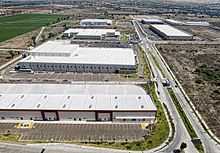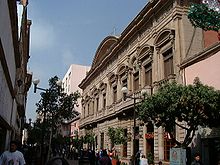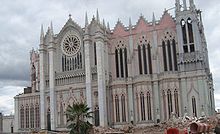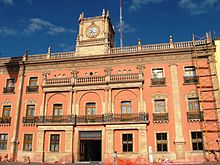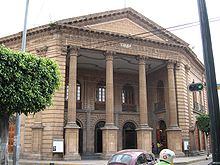- León, Guanajuato
-
León
León de los AldamaCity of León View of Gran Jardin Neighborhood 
Flag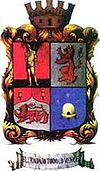
SealMotto: El trabajo todo lo vence Coordinates: 21°07′N 101°41′W / 21.117°N 101.683°WCoordinates: 21°07′N 101°41′W / 21.117°N 101.683°W Country  Mexico
MexicoState  Guanajuato
GuanajuatoFounded January 20, 1576 Government – Mayor Ricardo Sheffield PAN Area – Land 1,219.67 km2 (470.9 sq mi) Elevation 1,815 m (5,955 ft) Population (2010) – City 1,436,733 – Metro 1,792,047 Time zone CST (UTC−6) – Summer (DST) CDT (UTC−5) Area code(s) +52 Telephone exchange 477 Sources:
National Institute of Statistics, Geography and Data Processing[1]The city of León, formally León de los Aldama[2] is the sixth most populous city in Mexico [3] and the first in the state of Guanajuato. It is also the seat of the municipality of León. It has a strong leather industry, offering shoes, boots, belts, jackets, and other leather accessories both to national and international markets.
In the 2010 census the National Institute of Statistics, Geography and Data Processing (INEGI) reported 1,436,733 people living in the city of León, and 1,792,047 in the Greater Leon Metropolitan Area.[4]
Its first-class services and hotel industry turn it into one of the most important centers in Mexico with numerous options of entertainment, gastronomy, leisure activities, arts and recreation.[5]
It is also considered one of the most environmentally friendly cities in Mexico and has a high number of cyclists, in part because of its integration a network of bike lanes to the SIT system.[6]
Contents
General data
Population
In the 2010 census the National Institute of Statistics, Geography and Data Processing (INEGI) reported 1,436,733 people living in the city of León, and 1,792,047 in the metropolitan area, which includes the neighbouring municipality of Silao, Purísima del Rincón and San Francisco del Rincón.[7] The municipality of León, which has an area of 1,219.67 km² (490.92 sq mi), also includes numerous smaller outlying communities, the largest of which are Centro Familiar la Soledad, Medina, and La Ermita.
There is a large Argentinian immigrant community in the city, as well as one formed by descendants of Lebanese immigrants.
Public transportation system
The city's public transportation system features a mix of buses and the Optibus bus rapid transit colloquially known as "La Oruga" (The Caterpillar). The municipally-operated Oruga started its operation on September 27, 2003; León pioneered its use in Mexico. León is served by Del Bajío International Airport which is located in the city of Silao. [1]
Health
León is a regional health center, there are important hospitals like Ramirez Guadiana, Aranda de la Parra, Angeles, Medica Campestre.
Industrial parks
60% of the shoes produced in Mexico are made in León, and there are also chemical industry, leather, transportation, plastic, polymer, box companies. There is also cluster of automotive industries, including a General Motors plant in the nearby municipality of Silao. León is also national headquarters of the bank Banco del Bajío owned by Salvador Oñate, and is the headquarters of regional divisions of banks such as Banamex, HSBC etc.
Customs facility
A newly built facility within GTO Inland Port’s premises speeds up the logistics process. Clearing customs in a border city or seaport is no longer a requirement for companies located in GTO Inland Port; now they use this very convenient facility.
Rail container facility
A rail container yard is now offering inter-modal services for rail transportation. The facility is operated by the largest rail company in Mexico and has one of the longest rail spurs in the Country.
Guanajuato International Airport
The most well connected regional airport is located adjacent to GTO Inland Port. The passenger terminal has several non-stop daily flights to US cities such as Houston (IAH), Dallas (DFW) and Los Angeles (LAX).
A new air cargo area is part of GTO Inland Port’s master plan which will have a direct connection to the airport’s runway
Expositions
In the Poliforum there are trade fairs throughout the year. The principal two are Sapica (Shoe Fair), and ANPIC (suppliers of the shoe industry).
History
In the León area there are ten distinct archeological zones, dating from the pre-classic Mesoamerican period.[8] Most of these are identified with the Chupícuaro culture.[9] By the Classic period, the area was under Teotihuacan and Toltec influence. In the 13th century, the Chichimecas, mostly of the Guamare and Guachichil subgroups, overran the area, migrating from an area of what is now San Luis Potosí. They remained through the Colonial period.[8][9]
In 1530 Nuño Beltrán de Guzmán arrived with allied Tarasco Indians to the area, naming it Nuestra Señora.[8] Homesteads were granted by the governor of Nueva Galicia Francisco Vázquez de Coronado to Spaniards Rodrigo de Vázquez and Juan de Jasso.[9] Farming and cattle-raising was introduced here around 1546 by the Spaniards but these settlers were under constant threat by the Chichimecas, who recognized the Spanish as invaders. These settlers requested assistance from the viceregal authorities in Mexico City.[8][9]
As a response, viceroy Martín Enríquez de Almanza ordered the founding of a city here, with the name of León in 1575. To carry out the order, Juan Bautista de Orozco founded the village of León on 20 January 1576, creating its first town council and laying out its initial streets. In 1580, it attained the rank of "alcadía mayor" meaning it has governing authority of much of the land and smaller towns surrounding it from the Sierra de Comanja to the Lerma River.[8][9] For example, two other towns founded in the area were San Miguel and Coecillo. In San Miguel, the Spaniards settled the Otomi peoples and in Coecillo were settled the Purépechas, Mexicas and the Chichimecas that did not oppose Spanish rule. As the population of the area grew, a number of municipalities would eventually break off, such as San Francisco del Rincón, Purísima del Rincón (Purísima Concepción), Cd. Manuel Doblado (San Pedro Piedra Gorda), Huanímaro, Abasolo, Cuerámaro and Pénjamo.[9]
In 1582, the first hospital of San Cosme y San Damián was established by Father Espino.[9]
The Jesuits arrived to León in 1731, founding the "Compañía Vieja" which is now the site of the Temple of the Immaculate. They also constructed the Temple of the New Company, which would become the Cathedral, however they never finished it as they were expelled from Mexico in 1767. On 2 July 1732 arrived an image of Our Most Holy Mother of Light. She would later be declared the patron saint of the city, in 1849.[9]
The population of the area suffered epidemics in 1643, droughts in 1630 and 1712–1714, famines in 1714 and 1786, and flooding in 1637, 1749, 1762 and 1803.[9]
Independence forces under José Rafael de Iriarte arrived to the town on 4 October 1810. However, two months later royalist forces under Felix Calleja retook the locality, with insurrectionist sympathizers facing reprisals.[8] About 2,000 insurgents on horses attacked the town but were repulsed by Count Pérez Gálvez.[9] Royalist forces were attacked here in 1817 by Francisco Javier Mina without success. The town remained in royalist hands until the end of the Mexican War of Independence, when Agustín de Iturbide arrived.[8] The town did not celebrate its first Grito de Dolores to mark independence until 1825. In 1827 it became one of the four "departments" of the newly-created state of Guanajuato, and in 1830, it gained city status.[9]
In 1840, Father Ignacio Aguado founded the College of San Francisco de Sales and the College of La Madre Santísima was founded in 1844.[9]
During La Reforma War, the city changed hands various times between Liberal and Conservative forces between 1858 and 1860. The most notable battle of that war here was when General José Iniesta attacked the town on 18 February 1859. In that same year, León even separated for a time from the rest of the state of Guanajuato.[9]
In 1862 the bishopric of León was founded, separating the city of León and nine other municipalities such as Irapuato, Guanajuato and Dolores Hidalgo from the bishopric of Michoacán. Bishop Diez de Sollano opened the Conciliar Seminary in 1864. This bishop consecrated the Basilica Cathedral in 1866, even though it was not completed, giving the image of the Virgin of the Light a permanent home.[9]
From 1863 to 1866, the French occupied León during the French Intervention, with Emperor Maximillian visiting the city in 1864. His arrival was much celebrated here, with fireworks and a hot air balloon exhibition put on by the Alemán brothers. However, when Liberal forces finally had permanent control over the town, two incidents occurred. On 30 September 1867, Coronel Cecilio Delgado Estrada ordered his men to shoot over the heads of people who prayed in the streets, causing some to be wounded. Another incident of this type occurred in 1877. The second was more permanent. The Liberals decommissioned the convent and college of Saints Peter and Paul, converting it into offices for city government. It remains such to this day.[9]
On 2 January 1946 a mob gathered in the plaza in front of the municipal palace to protest elections seen as illegitimate. These protesters were fired upon, killing many. This plaza has been named the "Plaza of the Martyrs" in their honor.[8]
Plans
Global Rainmakers will roll out a program to install iris scanners in León. The plan to install these scanners and the potential risks to personal privacy were discussed on the Katherine Albrecht show on August 31, 2010.
Notable sites
Cathedral
The main church is called the Basilica Cathedral of Our Holy Mother of the Light and is the seat of the Archdiosis of Leon. Construction of the church was begun in 1746 by the Jesuits and is a combination of Baroque and Neo Classic architectural styles. Construction was halted only eight months after it began when the Jesuit order was expelled from Mexico by the Spanish Crown. The Obregon family, however, took over its construction, continuing into the 19th century. The Archdiosis of Leon was created in 1864, with its first bishop, José María de Jesús Diez de Sollano y Dávalos helping to get the towers and cupola completed as he chose the church as the seat. It was finally completed and consecrated on 16 March 1866.[10]
Expiatorio
Its full name is the Santuario Expiatorio del Sagrado Corazón de Jesús (Expiatory Sanctuary of the Sacred Heart of Jesus). Construction of this temple was begun in 1920 by Bernardo Chavez with the support of Bishop Emeterio Valverde y Téllez. It is neo Gothic in design, based on the old European medieval cathedrals but much of the outide wallspace is without decoration. Its work was halted by the Cristero Wars. Since then construction has continued off and on and it is considered 80% complete. An important source of income for the temple's construction is the sale of crypts. This practice was begun in 1924. A chapel dedicated to the Virgin of Lourdes was begun in 1935 and later a chapel dedicated to the Virgen of Guadalupe, which is separate from the main building, built between 1935 and 1939.[11]
Municipal Palace
The current Municipal Palace is of Ionic architectural style and occupies part of the site of the old "Colegio Grande del Seminario de los Padres Paulinos" (Grand Seminary College for Pauline Priests) who had to abandon the city in 1860.[12]
From 1861 to 1867 it was a military barracks. After the French Intervention, it was remodeled to conserve its original architecture by Coronel Octaviano Rosado to become the seat of government on 21 March 1869. The patio of the building contains a bronze statue of Benito Juarez to commemorate the centennial of his death in 1972. Since then, the building has had a number of additions such as the dome that now covers this patio, and a number of murals. These murals were painted in 1972 and 1973 by Jesus Gallardo covering the walls of the main stairwell and the hallway of the upper floor around the patio.[12]
Portal of the Millennium
This monument was built to celebrate the arrival of the new millennium and has become a landmark for arrival into the city. There was some concern that the monument would not be ready for New Year's 2000, however the 45-meter tall tower on five plinths was completed on time. It was built in a 5,400 square meter plaza, planted with trees. The project cost 4.5 million pesos.[13]
Heroes' Causeway Arch
This arch (Arco de la Calzada de los Héroes, in Spanish), topped by a bronze lion, was begun in 1896 and has been modified a number of times in the hundred years or so since then. The first lion was added in 1943 by Francisco Lozornio Castillo made of bricks and mortar. This was replaced by the bronze one in 1958. The idea for a bronze lion was that of famous matador Antonio Velázquez, a native of Leon, whose bravery in the ring earned him the nickname of the "Heart of Leon".[14] Not long before his death in 1959, he complained that the brick lion should be replaced with a better work of art, causing something of a commotion in the Leon community. This caught the attention of sculpture Humberto Peraza Ojeda who made the one that sits atop the arch today.[14]
Transportation
Del Bajío International Airport
The Del Bajío International Airport (Guanjuato International Airport) serves the city, although it is located in the neighboring city of Silao.
Cycling
The city's bicycle paths are extensive. Leon is one of the most bicycle-friendly large cities in Latin America and has an extraordinary track record in active transport, keeping the biking and walking share above 39% of the total trips, one of the highest values in Latin American cities.[15]
Integrated Transportation System
Integrated Transportation System (ITS) (Sistema Integrado de Transporte in Spanish) refers to the development and implementation of a Bus rapid transit system named “Optibus”. Since September 28th, 2003 the Integrated Transport Optibús began to operate despite an existing need for a subway system "Metro", which originally was planned construction with two lines.
The system was the first of its kind in Mexico. Leon being the first city in the country with a BRT system, before it is implemented in Mexico City as Metrobus and Guadalajara as Macrobus.
Optibús System The current route system is divided into four categories. These are:
- Trunk routes: They consist of five main lines that cross the city from end to end. The buses are also known as Orugas (caterpillars in Spanish) due to its articulated mid section. They have capacity for 175 passengers. The Optibus transit system consists of 52 stations located in the central area of the main avenues of the city.
- Feeder and Auxiliary Routes: These are urban bus routes that were integrated into the regular system, as a stop as they have one or more transfer stations. Are identified by the letter A (Feeder route / yellow decals) or X (Auxiliary route / blue decals).
- Conventional Routes: These routes that circulate through most of the city and are distinguished by having the corporative colors from its owners: orange, red, pink, purple and green.
- Suburban Roads: Roads are circulating outside or on the city edge communities as Comanjilla, Duarte, Loza de los Padres, La Hacienda, etc.
There are currently three permanent transfer stations (San Jeronimo, Delta de Jerez and San Juan Bosco), two micro-stations (Santa Rita - Parque Juarez), which are the endpoints for trunk routes, feeder routes and auxiliary routes. At these stations are allowed to transfer without cost from any of these lines.
In addition, as a control measure, the “PagoBus” system has been instituted; this is an electronic card system that allows users to streamline their access to stations and bus and thus save money. There are 2 types of cards: Preferential and General, cost rates with 50 and 15% lower total cost.
The environmental benefits of the system are also high, not least because the system introduced articulated buses using Euro IV technology and ultra low sulfur, resulting in 5,600 tons of CO2 reduction annually.[16]
Education and research
The Universidad Nacional Autónoma de México (UNAM) has begun to build a campus in the city of León (first one outside Mexico City) to serve 15,000 students in the west of Mexico. The project will be built on a 60 hectare site in the south of the city to serve students in Guanajuato, Jalisco, Aguascalientes, Querétaro, San Luis Potosí, Michoacán and Zacatecas, starting in 2011.[17]
Universities
- University of Guanajuato
- National Autonomous University of Mexico
- Ibero-American University
- Monterrey Institute of Technology and Higher Education
- National Polytechnic Institute
- La Salle University
- Polytechnic of Guanajuato
Sports
Football
The city's main professional soccer team is Club León, which is one of the foremost teams in Mexico, five-time league champion, now playing in the Primera División A. The team's stadium, Estadio León, also bears a Catalan name: Nou Camp. FIFA World Cup games have been played there (1970 and 1986).
A new franchise with the name of Curtidores appeared in the Primera División A in the mid-1990s, but, after being champion in 1999 and earning the right to play in the Primera División, was sold and moved to Puebla to become Puebla, F.C. In 2007 a new franchise named Union de Curtidores began playing at Segunda división. Nowadays, there are several soccer teams in the city playing in the Tercera División: Atlético ECCA, Juventud Cuerera and Conmudaj, among some others along with the women's league, Super Liga Femenil de Futbol.
Rally Mexico (WRC)
Since 2004 the city has hosted the headquarters of Rally Mexico located at the Centro de Convenciones Poliforum Leon, one round of the World Rally Championship. Thousands of fans camp at the nearby Sierra de Lobos to watch the rally. The Rally takes place in three cities: Guanajuato, Silao and León.
Basketball
Since 2004, León has a basketball team, Lechugueros, which plays in the Liga Nacional de Baloncesto Profesional (LNBP). They play in the Domo de la Feria (formerly known as Auditorio Municipal). Before this team, the city had other professional basketball teams: Lechugueros (original franchise), Zapateros, Pony-León and Atléticos. These teams participated in the CIMEBA (Circuito Mexicano de Básquetbol), which was the main basketball league of Mexico in the 1970s and 1980s.
Baseball
León had two baseball teams in the Liga Mexicana de Beisbol: Cachorros de León, in the late 1970s, and Bravos de León, in the late 80's. Bravos, after becoming champions of the league in 1990, and due to financial problems, were sold and moved to Minatitlán, Veracruz. Since then, attempts to bring a new baseball team to the city have been unsuccessful.
Tennis
León has been a host city for the yearly ATP Challenger Tour since 1992.
Notable natives and residents
- Vicente Fox, President of Mexico from 2000 to 2006 and Governor of Guanajuato, owned a ranch in San Francisco del Rincón.
- Carlos Medina Plascencia, politician affiliated to the conservative National Action Party and former mayor.
- María Grever, famous composer.
International relations
Sister Cities
 San Diego, United States
San Diego, United States
 Laredo, United States
Laredo, United States
 Irving, United States
Irving, United States
 Las Vegas, Nevada, United States
Las Vegas, Nevada, United States
 Los Angeles, United States
Los Angeles, United States
 Cangas de Onis, Spain
Cangas de Onis, Spain
 Fermo, Italia
Fermo, Italia
 Bogota, Colombia
Bogota, Colombia
 Suzhou, China
Suzhou, China
 Novo Hamburgo, Brasil
Novo Hamburgo, Brasil
References
- ^ a b INEGI
- ^ E-Local -Guanajuato
- ^ http://www.am.com.mx/Nota.aspx?ID=441354
- ^ http://www.am.com.mx/Nota.aspx?ID=441354
- ^ http://www.ocvleon.com/?mod=visitors]
- ^ http://www.itdp.org/index.php/news/detail/sustainable_transport_award_cities_leon
- ^ http://www.am.com.mx/Nota.aspx?ID=441354
- ^ a b c d e f g h "Enciclopedia de los municipios Guanajuato Leon" (in Spanish). http://www.e-local.gob.mx/work/templates/enciclo/guanajuato/index.html. Retrieved 2008-10-18.
- ^ a b c d e f g h i j k l m n o "Leon Guanajuato Historia" (in Spanish). http://www.ruelsa.com/gto/leon/leon4.htm. Retrieved 2008-10-18.
- ^ "Catedral Basicilia" (in Spanish). http://www.leonguanajuato.com/catedral/. Retrieved 2008-10-16.
- ^ "Templo Expiotorio" (in Spanish). http://www.skyscrapercity.com/showthread.php?t=302555. Retrieved 2008-10-20.
- ^ a b "Palacio Municipal" (in Spanish). http://www.leon.gob.mx/portal/modules/icontent/index.php?page=22. Retrieved 2008-10-17.[dead link]
- ^ "Puerta del Milenio" (in Spanish). http://www.leon.gob.mx/portal/modules/icontent/index.php?page=30. Retrieved 2008-10-17.[dead link]
- ^ a b Rubén Rodríguez Molina. "UNA HISTORIA DIFERENTE" (in Spanish). http://www.leon.gob.mx/portal/modules/icontent/index.php?page=26. Retrieved 2008-10-17.[dead link]
- ^ http://www.itdp.org/index.php/sustainable_transport_award
- ^ http://www.itdp.org/index.php/news/detail/sustainable_transport_award_cities_leon
- ^ "UNAM-Guanajuato atenderá a 15 mil alumnos [UNAM-Guanajuato to attend to 15,000 students]" (in Spanish). El Universal. Agencia el Universal (Mexico City). October 5, 2010.
- Andanzas. Biannual Magazine, published by the Human Sciences Department, Universidad Iberoamericana Plantel León. 1994-
- Enciclopedia de México. Secretaría de Educación Pública. 1987.
- "León. Trayectoria y Destino". González Leal, Mariano. Gonzalo Andrade Ed. H. Ayuntamiento de León, Guanajuato. 1990.
- "León... Pueblo Accidentado". Rivera Tafoya, Antonio. 1983.
- "Recordatorios Públicos y Privados, León". 1864-1908. Esquivel Obregón, Toribio. Consejo para la Cultura de León AC 1992.
- "Remembranzas Leonesas de mi niñez". Torres Madrazo, Manuel. Imprenta Lumen, León, Gto. 1993
- "Sitios Arqueológicos del Municipio de León". Ramos de la Vega, Jorge. Ramírez Garayzar, Amalia. #3 Colección Entornos. Universidad Iberoamericana. Plantel León. 1993.
- Link to tables of population data from Census of 2005 INEGI: Instituto Nacional de Estadística, Geografía e Informática
- Guanajuato Enciclopedia de los Municipios de México
- Sister Cities: http://www.leon.gob.mx/noticias/index.php?idarticulo=634 (In Spanish)
External links
- Portal de León Official website
- WWW.LeonGuanajuato.COM Portal LeonGuanajuato.COM
- Periódico a.m. The region's leading daily newspaper
- www.discover-leon.com — Guide to Leon, Mexico.
Municipalities Abasolo · Acámbaro · San Miguel de Allende · Apaseo el Alto · Apaseo el Grande · Atarjea · Celaya · Manuel Doblado · Comonfort · Coroneo · Cortázar · Cuerámaro · Doctor Mora · Dolores Hidalgo · Guanajuato · Huanímaro · Irapuato · Jaral del Progreso · Jerécuaro · León · Moroleón · Ocampo · Pénjamo · Pueblo Nuevo · Purísima del Rincón · Romita · Salamanca · Salvatierra · San Diego de la Unión · San Felipe · San Francisco del Rincón · San José Iturbide · San Luis de la Paz · Santa Catarina · Santa Cruz de Juventino Rosas · Santiago Maravatío · Silao · Tarandacuao · Tarimoro · Tierra Blanca · Uriangato · Valle de Santiago · Victoria · Villagrán · Xichú · Yuriria Categories:
Categories:- León (Guanajuato)
- Populated places in Guanajuato
- Municipalities of Guanajuato
Wikimedia Foundation. 2010.



